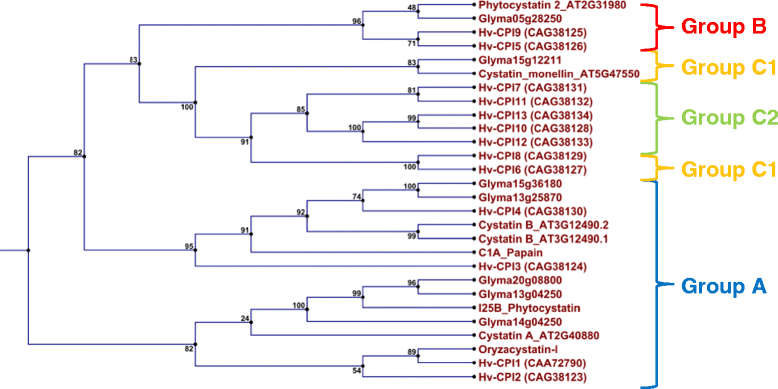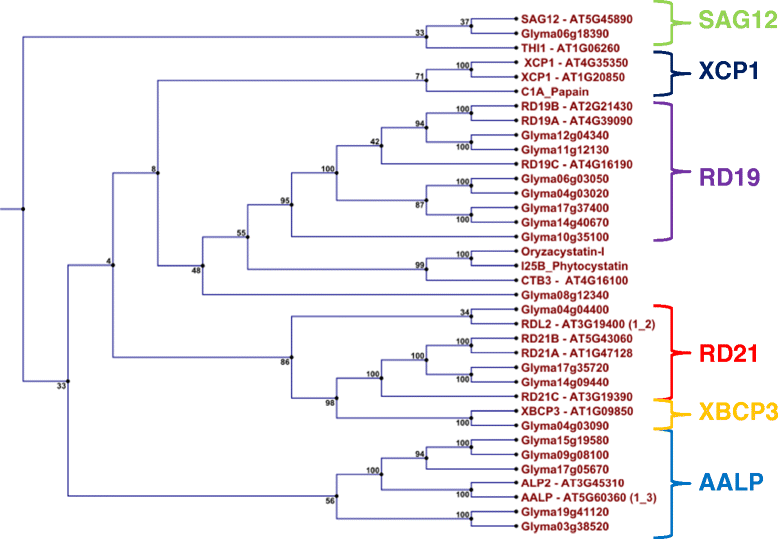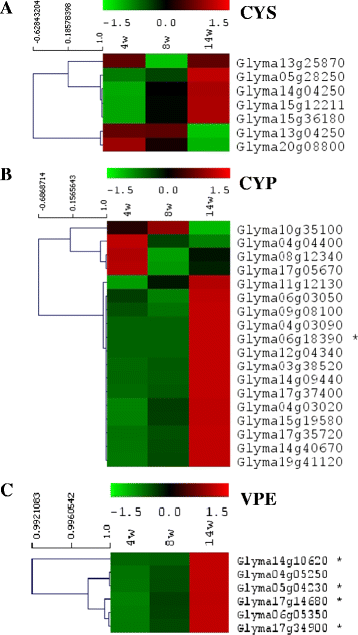Cysteine protease and cystatin expression and activity during soybean nodule development and senescence
- PMID: 25404209
- PMCID: PMC4243279
- DOI: 10.1186/s12870-014-0294-3
Cysteine protease and cystatin expression and activity during soybean nodule development and senescence
Abstract
Background: Nodules play an important role in fixing atmospheric nitrogen for soybean growth. Premature senescence of nodules can negatively impact on nitrogen availability for plant growth and, as such, we need a better understanding of nodule development and senescence. Cysteine proteases are known to play a role in nodule senescence, but knowledge is still fragmented regarding the function their inhibitors (cystatins) during the development and senescence of soybean nodules. This study provides the first data with regard to cystatin expression during nodule development combined with biochemical characterization of their inhibition strength.
Results: Seventy nine non-redundant cysteine protease gene sequences with homology to papain, belonging to different subfamilies, and several legumain-like cysteine proteases (vacuole processing enzymes) were identified from the soybean genome assembly with eighteen of these cysteine proteases actively transcribed during nodule development and senescence. In addition, nineteen non-redundant cystatins similar to oryzacystatin-I and belonging to cystatin subgroups A and C were identified from the soybean genome assembly with seven actively transcribed in nodules. Most cystatins had preferential affinity to cathepsin L-like cysteine proteases. Transcription of cystatins Glyma05g28250, Glyma15g12211, Glyma15g36180 particularly increased during onset of senescence, possibly regulating proteolysis when nodules senesce and undergo programmed cell death. Both actively transcribed and non-actively transcribed nodule cystatins inhibited cathepsin-L- and B-like activities in different age nodules and they also inhibited papain and cathepsin-L activity when expressed and purified from bacterial cells.
Conclusions: Overlap in activities and specificities of actively and non-actively transcribed cystatins raises the question if non-transcribed cystatins provide a reservoir for response to particular environments. This data might be applicable to the development of strategies to extend the active life span of nodules or prevent environmentally induced senescence.
Figures




Similar articles
-
Genome-wide survey of soybean papain-like cysteine proteases and their expression analysis in root nodule symbiosis.BMC Plant Biol. 2020 Nov 12;20(1):517. doi: 10.1186/s12870-020-02725-5. BMC Plant Biol. 2020. PMID: 33183238 Free PMC article.
-
Search for Nodulation and Nodule Development-Related Cystatin Genes in the Genome of Soybean (Glycine max).Front Plant Sci. 2016 Oct 25;7:1595. doi: 10.3389/fpls.2016.01595. eCollection 2016. Front Plant Sci. 2016. PMID: 27826313 Free PMC article.
-
Characterization of the entire cystatin gene family in barley and their target cathepsin L-like cysteine-proteases, partners in the hordein mobilization during seed germination.Plant Physiol. 2009 Nov;151(3):1531-45. doi: 10.1104/pp.109.146019. Epub 2009 Sep 16. Plant Physiol. 2009. PMID: 19759340 Free PMC article.
-
C1A cysteine protease-cystatin interactions in leaf senescence.J Exp Bot. 2014 Jul;65(14):3825-33. doi: 10.1093/jxb/eru043. Epub 2014 Mar 5. J Exp Bot. 2014. PMID: 24600023 Review.
-
Phytocystatins and their Potential Application in the Development of Drought Tolerance Plants in Soybeans (Glycine max L.).Protein Pept Lett. 2020;27(2):135-144. doi: 10.2174/0929866526666191014125453. Protein Pept Lett. 2020. PMID: 31612812 Review.
Cited by
-
Insight into the control of nodule immunity and senescence during Medicago truncatula symbiosis.Plant Physiol. 2023 Jan 2;191(1):729-746. doi: 10.1093/plphys/kiac505. Plant Physiol. 2023. PMID: 36305683 Free PMC article.
-
Uncovering Bax inhibitor-1 dual role in the legume-rhizobia symbiosis in common bean roots.J Exp Bot. 2019 Feb 5;70(3):1049-1061. doi: 10.1093/jxb/ery417. J Exp Bot. 2019. PMID: 30462254 Free PMC article.
-
Papain-like cysteine proteases in Carica papaya: lineage-specific gene duplication and expansion.BMC Genomics. 2018 Jan 6;19(1):26. doi: 10.1186/s12864-017-4394-y. BMC Genomics. 2018. PMID: 29306330 Free PMC article.
-
Drought Stress Responses in Soybean Roots and Nodules.Front Plant Sci. 2016 Jul 12;7:1015. doi: 10.3389/fpls.2016.01015. eCollection 2016. Front Plant Sci. 2016. PMID: 27462339 Free PMC article. Review.
-
A mitochondrial metalloprotease FtsH4 is required for symbiotic nitrogen fixation in Lotus japonicus nodules.Sci Rep. 2024 Nov 11;14(1):27578. doi: 10.1038/s41598-024-78295-5. Sci Rep. 2024. PMID: 39528551 Free PMC article.
References
Publication types
MeSH terms
Substances
LinkOut - more resources
Full Text Sources
Other Literature Sources

